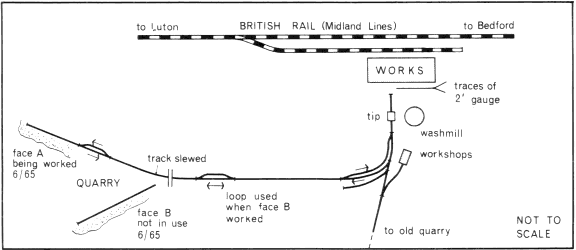
| THE INDUSTRIAL RAILWAY RECORD |
© APRIL 1971 |
INDUSTRIAL RAILWAYS OF BEDFORDSHIRE
| SUNDON CEMENT WORKS |
SYDNEY A. LELEUX |
(photographs by the author)
The Sundon Works of Associated Portland Cement Manufacturers Ltd is situated a few miles north of Luton, Bedfordshire, beside the former Midland Railway main line and the M1 Motorway. A busy 3ft 0in gauge railway brings chalk from the quarry to the works, a distance of about half a mile.
The level track of the railway is single with a passing loop at each end and a now-disused loop midway along. Near this loop, there is a bridge carrying a footpath over the railway. At the works end of the line are several sidings and the locomotive repair shop. Main line rail is 50lb per yard, but the prefabricated points and the curved sides of the loops (for empty trains) are of lighter material. Stepped fishplates are used to connect rails of different sections. Old British Railways sleepers, cut in half, provide a rather short sleeper in relation to the gauge although, at the entrance to the quarry, an area of soft ground requires the use of whole sleepers. Points are sprung but can be adapted for manual operation by the removal of an iron bar.
Motive power is provided by three Motor Rail Simplex diesels (3797 of 1926, 3965 of 1939, and 10118 of 1949 the first two being rebuilds of locomotives originally built for the War Department Light Railways) while the frames of two more such locomotives lie near the works. There is also an example of the few Fowler narrow gauge locomotives still extant in Britain (3930044 of 1950) which is not very popular and is kept as a spare. Rolling stock consists of twenty-one 3-cubic yard Hudson side-tipping wagons, plus an old underframe which serves as a flat wagon. Each wagon is numbered, the figures being made up of small dots of welding metal, and the livery is either pale yellow or pale pink.
Two locomotives and three rakes of six wagons are needed for daily use. The wagons are propelled to the pit and hauled back. On arrival at the works the train is left in the loop while the locomotive uncouples and runs round to push the rake of empties, standing on the other track of the loop, back to the quarry. A steel cable is meanwhile attached to the full train which is then winched up a slight gradient and past the tip into the washmill. The train is then slowly run down past the tip and the wagons are tipped in turn, after which they run back to the loop to await the return to the quarry.

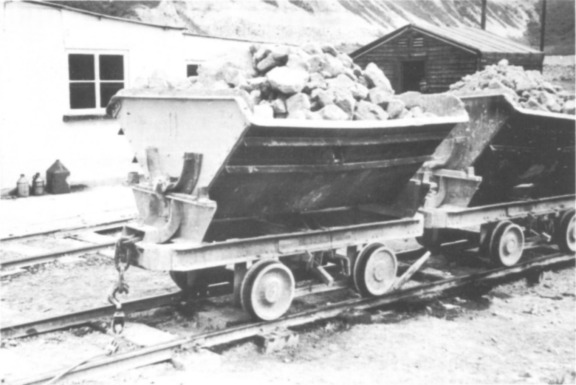
One of the Hudson side-tipping wagons with winch rope attached.
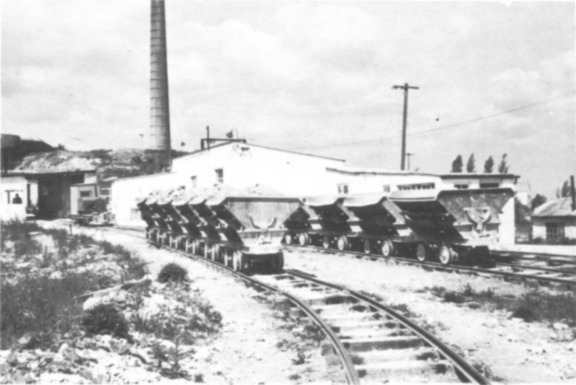
general view of the works with Motor Rail 10118 about to back on to a rake of empties. Note the short sleepers.
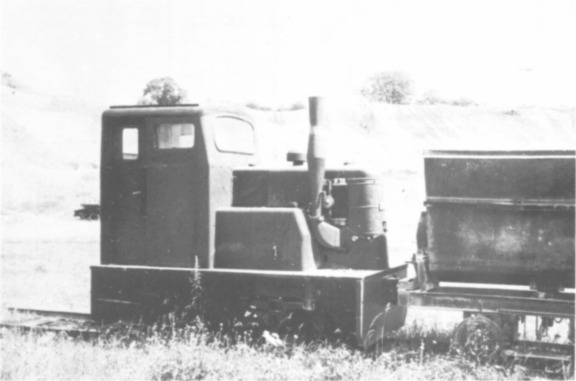
Fowler 3930044 of 1950 has no running number.
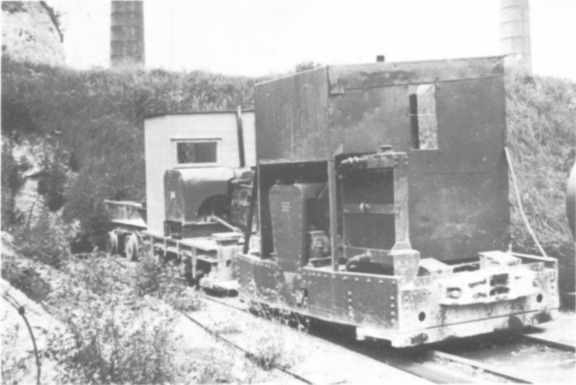
Motor Rail 10118 (left) and Motor Rail 3965 (right) carry running numbers 3 and No.2 respectively.
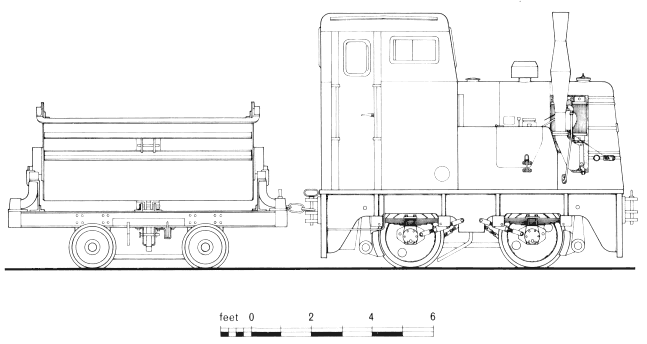
Fowler 3ft. 0in. gauge diesel locomotive No. 3930044 and Hudson tipper.
A.P.C.M. Sundon
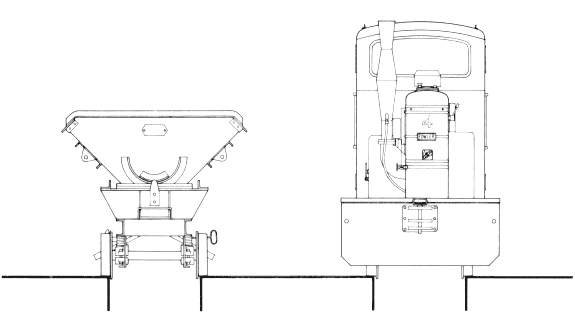
The Sundon locomotive depicted here was apparently one of only a small number of this design produced. They were based on the later developments of the single cylinder diesel engined agricultural tractor built by Marshall. Sons & Co. Ltd. of Gainsborough a machine which had proved very popular in its own sphere. MarshaIls were, by that time, a member of the Fowler organisation. The only further examples known to have been delivered for use in this country were Nos. 3930037 and 3930048. built for the North Devon Clay Co. Ltd., Peters Marland in 1949 and 1951 respectively. Is anyone able to add further information on these somewhat unusual hybrids? (REW)
There is no locomotive shed; the two working locomotives are kept on the neck beyond the washmill when not in use, while the workshop houses a third locomotive. At the end of the day, the works loop contains two rakes, one full and one empty, while the last train from the quarry is left at the entrance to the loop.
Under the kilns there is a length of 2ft 0in gauge track, the one remaining wagon for this line having a high capacity steel body and a channel underframe. This line appears to have once served a coal dump and the British Railways siding, and was perhaps used for carrying coal to the kilns. The BR siding, having a steep gradient, is worked by a winch.
I should like to thank Mr W. A. Easton, the Works Manager, for his help with this article which is based on observations made in June 1965 although the position was unchanged in 1969.
EAST AND WEST INDIA DOCK COMPANY. The other locomotive, the SWIFT, has rather a curious history. It was one of three constructed for the Khedive of Egypt but not paid for before his bankruptcy. It was originally built to a metre gauge and had to be rebuilt before delivery to the Dock Company. Although it is not known in what colour it was painted, the Railway Superintendent wrote in 1880 "I would suggest a light colour because you would then see the slightest bit of dirt and so at once ascertain whether the driver is taking any interest in his engine or otherwise." ("PLA Monthly" No.427, May 1961. The SWIFT, an 0-6-0 saddle tank (Fowler 3807 of 1880), was taken over by the Port of London Authority in 1909 and sold (for scrap?) in 1914 KPP)
"The Piraeus and Larissa Railway, which was begun in 1890, is making fair progress. The contract for this railway, which is by far the most important railway in Greece, was given in July 1889, to Messrs. Eckersley, Godfrey, and Liddelow, of London, and confirmed by Royal decree in November of the same year." ("The Railway Engineer, "July 1893)
"The works on this line undertaken by the English contractors were abandoned this year. By a public decree of the Minister of the Interior, Messrs. Eckersley, Godfrey and Liddelow were declared to have forfeited their contract owing to their having abandoned the works for want of means to continue them, notwithstanding the advances made by Government, and also owing to their having made an application to the Bankruptcy Court in London, .... The contractors protested against this decree, declaring that the Government had not kept up its payments, and that no credit had been inserted in the budget for work still to be done, and they claim the sum of £453,605 from the Greek Government. At present about £1,000,000 appears to have been spent on the line without a single mile of it being open to traffic."
("The Railway Engineer," June 1895 KPP)
YAMBOLI BOURGAS RAILWAY, BULGARIA. "This line, the construction of which was commenced in the month of May, 1889, and finished in the month of May, 1890, was made entirely of unskilled labour, the men employed for the purpose being a regiment of pioneers, detachments from the regiments of Sliven, Varna, and Bourgas, the "Compagnie Disciplinaire," a corps consisting of criminals working out their sentences, and the peasants themselves; the best part of the work, it should be said, being performed by the latter."
("The Railway Engineer," November 1891 KPP)